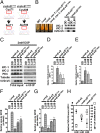Physical interaction between VIVID and white collar complex regulates photoadaptation in Neurospora
- PMID: 20733070
- PMCID: PMC2944764
- DOI: 10.1073/pnas.1011190107
Physical interaction between VIVID and white collar complex regulates photoadaptation in Neurospora
Abstract
Photoadaptation, the ability to attenuate a light response on prolonged light exposure while remaining sensitive to escalating changes in light intensity, is essential for organisms to decipher time information appropriately, yet the underlying molecular mechanisms are poorly understood. In Neurospora crassa, VIVID (VVD), a small LOV domain containing blue-light photoreceptor protein, affects photoadaptation for most if not all light-responsive genes. We report that there is a physical interaction between VVD and the white collar complex (WCC), the primary blue-light photoreceptor and the transcription factor complex that initiates light-regulated transcriptional responses in Neurospora. Using two previously characterized VVD mutants, we show that the level of interaction is correlated with the level of WCC repression in constant light and that even light-insensitive VVD is sufficient partly to regulate photoadaptation in vivo. We provide evidence that a functional GFP-VVD fusion protein accumulates in the nucleus on light induction but that nuclear localization of VVD does not require light. Constitutively expressed VVD alone is sufficient to change the dynamics of photoadaptation. Thus, our results demonstrate a direct molecular connection between two of the most essential light signaling components in Neurospora, VVD and WCC, illuminating a previously uncharacterized process for light-sensitive eukaryotic cells.
Conflict of interest statement
The authors declare no conflict of interest.
Figures






Similar articles
-
Biological Significance of Photoreceptor Photocycle Length: VIVID Photocycle Governs the Dynamic VIVID-White Collar Complex Pool Mediating Photo-adaptation and Response to Changes in Light Intensity.PLoS Genet. 2015 May 15;11(5):e1005215. doi: 10.1371/journal.pgen.1005215. eCollection 2015 May. PLoS Genet. 2015. PMID: 25978382 Free PMC article.
-
VIVID interacts with the WHITE COLLAR complex and FREQUENCY-interacting RNA helicase to alter light and clock responses in Neurospora.Proc Natl Acad Sci U S A. 2010 Sep 21;107(38):16709-14. doi: 10.1073/pnas.1009474107. Epub 2010 Aug 31. Proc Natl Acad Sci U S A. 2010. PMID: 20807745 Free PMC article.
-
Photoadaptation in Neurospora by competitive interaction of activating and inhibitory LOV domains.Cell. 2010 Sep 3;142(5):762-72. doi: 10.1016/j.cell.2010.08.010. Cell. 2010. PMID: 20813262
-
Light input and processing in the circadian clock of Neurospora.FEBS Lett. 2011 May 20;585(10):1467-73. doi: 10.1016/j.febslet.2011.03.050. Epub 2011 Mar 29. FEBS Lett. 2011. PMID: 21453703 Review.
-
[Photoreceptor apparatus of a fungus Neurospora crassa].Mol Biol (Mosk). 2005 Jul-Aug;39(4):602-17. Mol Biol (Mosk). 2005. PMID: 16083009 Review. Russian.
Cited by
-
No Evidence That Homologs of Key Circadian Clock Genes Direct Circadian Programs of Development or mRNA Abundance in Verticillium dahliae.Front Microbiol. 2020 Aug 28;11:1977. doi: 10.3389/fmicb.2020.01977. eCollection 2020. Front Microbiol. 2020. PMID: 33013740 Free PMC article.
-
Fungal photobiology: a synopsis.IMA Fungus. 2011 Jun;2(1):25-8. doi: 10.5598/imafungus.2011.02.01.04. Epub 2011 May 3. IMA Fungus. 2011. PMID: 22679584 Free PMC article.
-
The Resonance and Adaptation of Neurospora crassa Circadian and Conidiation Rhyth ms to Short Light-Dark Cycles.J Fungi (Basel). 2021 Dec 29;8(1):27. doi: 10.3390/jof8010027. J Fungi (Basel). 2021. PMID: 35049967 Free PMC article.
-
The aryl hydrocarbon receptor as a model PAS sensor.Toxicol Rep. 2021 Nov 26;9:1-11. doi: 10.1016/j.toxrep.2021.11.017. eCollection 2022. Toxicol Rep. 2021. PMID: 34950569 Free PMC article. Review.
-
Circadian rhythms synchronize mitosis in Neurospora crassa.Proc Natl Acad Sci U S A. 2014 Jan 28;111(4):1397-402. doi: 10.1073/pnas.1319399111. Epub 2014 Jan 13. Proc Natl Acad Sci U S A. 2014. PMID: 24474764 Free PMC article.
References
-
- Herrera-Estrella A, Horwitz BA. Looking through the eyes of fungi: Molecular genetics of photoreception. Mol Microbiol. 2007;64:5–15. - PubMed
-
- Heintzen C, Liu Y. The Neurospora crassa circadian clock. Adv Genet. 2007;58:25–66. - PubMed
-
- Corrochano LM. Fungal photoreceptors: Sensory molecules for fungal development and behaviour. Photochem Photobiol Sci. 2007;6:725–736. - PubMed
-
- Bahn YS, et al. Sensing the environment: Lessons from fungi. Nat Rev Microbiol. 2007;5:57–69. - PubMed
Publication types
MeSH terms
Substances
Grants and funding
LinkOut - more resources
Full Text Sources
Other Literature Sources
Molecular Biology Databases

